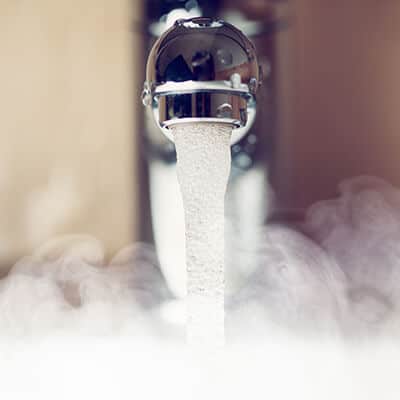How to Drain a Hot Water Heater

A hot water tank is likely the most used appliance at home and yet the most neglected. It ensures that you have a steady flow of hot water throughout the house for different purposes. With time, naturally occurring minerals and sand from municipal water lines may build up in the tank.
Such sediments form a thick coating at the bottom of the tank, diminishing heat transfer from the heating elements to the water. Eventually, the tank might rust or completely stop working. A hot water tank doesn’t require constant maintenance but often emptying it keeps it running at optimum efficiency. Follow the following steps to drain your water heater.
1. Start With a Quick Flush
First, connect a hose into the drain valve and try flushing the water heater tank when the pressure is still on. It will help remove some sediments stuck on the valve to make the draining process easier. If you notice many deposits coming out, you can repeat the process severally to remove as much debris as possible.
2. Shut Off the Water Supply
At the top of your water heater tank, you will see the cold water shut-off valve. You need to turn it to around 90 degrees to prevent water flow into the tank.
3. Turn Off Power
Next, you need to turn off the power to prevent burning the heating elements when the water level goes below them. If you are using a gas water heater, turn the thermostat into the pilot position. On the other hand, if you have an electric heater, turn the circuit breaker at the main breaker panel to disconnect the tank’s electricity supply. Check the label to ensure that you detach the right fuse. It’s also essential that you read through the manufacturer’s manual to understand instructions specific to your water heater brand.
It’s worth noting that even after turning off the gas or electric heating element, the water in the tank may remain significantly hot for some hours. It would be best to leave it cool overnight to prevent injury. Taking a hot shower will also help speed up the cooling process.
4. Attach a Hose to the Drain Valve
Once your water heater adequately cools, check below the tank to locate the drain valve. Put on protective gloves, place one end of a hose into the drain valve, and channel the other end to a bucket, driveway, or an empty trough. You can use a colander to trap sediments so that they don’t clog your drain as well.
If you notice any leak after connecting the hose, tighten it well using pliers. Still, be careful with the water coming out of the tank to ensure that you don’t get burned as you work. For a water heater in the basement, you might need to connect a manual pump to the hose and a separate hose that runs to the bucket to drain the water efficiently. However, if you feel uncomfortable handling the task, you can seek help from a qualified technician.
5. Turn on the Hot Water Pipe
Open a hot water tap, for instance, a sink faucet near the water tank heater, preferably on the floor above. It helps ease the pressure on the tank so that it drains quickly.
6. Drain the Tank
Now open the drain pipe to allow the water to flow out of the tank. Again, the water might still be hot so take caution. Note that it may take a considerable amount of time to completely drain the water, especially if the tank has too many sediments, so be patient. To speed up the process, remove one end of the hot water pipe above the heater and pull it a little sideways. It will allow air into the tank, which pushes the water to gush out.
7. Flush the Tank
Once you completely drain the tank, you now need to flush out any remaining sediments. Reopen the cold water supply with the drain valve still open to let the water out. Repeat the process until clear water starts running out.
Other times, the sediments can significantly block the drain valve opening, which limits water flow. In such a case, remove the drain valve to create more room for the deposits to escape. You can use a dowel or a long screwdriver to dislodge the buildup. Use large buckets to capture the outflow. If you didn’t get all the sediments out at this step, it would be best to seek an experienced technician’s assistance.
8. Close the Valve and Fill the Tank
When you no longer see any sediments coming out of the tank, turn the water supply off once more. Disconnect the hose, then shut off the drain valve. Remember to reconnect the hot water pipe above and tighten it adequately. Turn the water supply back on so that the water begins to flow into the tank.
You can also turn the hot water faucets on to remove air bubbles but shut them off once the normal water flow resumes. Don’t forget to turn off the hot water faucet opened earlier, in step five when the water begins to flow in the tank.
9. Restart the Water Heater
Once the tank is filled, you can relight your heater. Turn the gas valve off the pilot position and put the power back for your electric water heater. Confirm the water level before turning back the power connection to avoid damaging the heating element. Within an hour, you should have hot water throughout your house once again.
Before leaving, confirm whether you closed the drain valve completely. If you notice any leaks at the spout, place a cup over the hose thread’s outlet to stop the leak. You can even choose to replace the valve with a new one.
Wrapping Up
It’s crucial that you drain your hot water tank at least once a year. Still, if you reside in a hard water region, you may need to drain it more frequently to ensure that it provides plenty amount of hot water when needed at the lowest cost possible. When in doubt, it’s a good idea to consult a professional. A plumbing expert is very familiar with different water heater systems. A professional can drain and flush your system in the best way possible without creating messy water spills or other problems. As a professional plumber drains your tank, they can easily spot any other issues within your system and fix them early enough before they escalate into major problems, saving you on future expensive repairs or replacements.
If you need professional help in draining your water heater tank, you can always reach out to Brennan Heating & Air Conditioning. We offer fast and efficient water heater draining services even in peak seasons. We have a group of licensed and authorized professionals, well versed with both gas and electric water heaters. Our company also offers other services, including heating systems and air conditioner installation and maintenance services. You can also depend on us for energy consultation and air duct cleaning services. We serve Seattle, WA, and the surrounding areas. Call our friendly representatives today to book an appointment and enjoy our incredible services.







